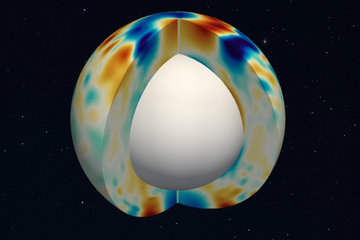All genres
21.
Journal Article
SUMER Observations of Coronal-Hole Temperatures. Space Science Reviews 172, pp. 57 - 68 (2012)
22.
Journal Article
Morphology, dynamics and plasma parameters of plumes and inter-plume regions in solar coronal holes. Astron. Astrophys. Rev. 19, 35 (2011)
23.
Journal Article
An explanation of the Pioneer anomaly involving accelerated atomic clocks. Astrophysics and Space Sciences Transactions 7, pp. 487 - 494 (2011)
24.
Journal Article
Quantitative solar spectroscopy. Astron. Nachrichten 331, pp. 502 - 511 (2010)
25.
Journal Article
Stereoscopic polar plume reconstructions from STEREO/SECCHI images. Astrophysical Journal 700, pp. 292 - 301 (2009)
26.
Journal Article
The Structure and Origin of Solar Plumes: Network Plumes. Astrophysical Journal 700, pp. 551 - 558 (2009)
27.
Journal Article
The solar plasma conditions in the source regions of two explosive events. Astronomy and Astrophysics 495 (2), pp. 613 - 620 (2009)
28.
Journal Article
Multi-spacecraft observations of polar coronal plumes. Astronomy and Astrophysics 481, pp. L61 - L64 (2008)
29.
Journal Article
Comment on ``Energy levels and spectral lines of NeVIII''. Eur. Phys. J. D 47 (3), p. 325 - 325 (2008)
30.
Journal Article
Observations supporting the role of magnetoconvection in energy supply to the quiescent solar atmosphere. Astrophysical Journal 654, pp. 650 - 664 (2007)
31.
Journal Article
Observations of the Sun at Vacuum-Ultraviolet Wavelengths from Space. Part II: Results and Interpretations. Space Science Reviews 133, pp. 103 - 179 (2007)
32.
Journal Article
Solar coronal-hole plasma densities and temperatures. Astronomy and Astrophysics 455 (2), pp. 697 - 708 (2006)
33.
Journal Article
Solar VUV measurements obtained by SOHO instruments and their radiometric calibration. Advances in Space Research 37 (2), pp. 225 - 233 (2006)
34.
Journal Article
A new relation between the central spectral solar H I Lyman α irradiance and the line irradiance measured by SUMER/SOHO during the cycle 23. Icarus 178, pp. 429 - 433 (2005)
35.
Journal Article
Variation of the full Sun hydrogen Lyman profiles through solar cycle 23. Advances in Space Research 35, pp. 384 - 387 (2005)
36.
Journal Article
Explosive events in the solar atmosphere seen in extreme-ultraviolet emission lines. Astronomy and Astrophysics 431, pp. 339 - 344 (2005)
37.
Journal Article
Correlation heights of the sources of solar ultraviolet emission lines in a quiet-sun region. Astrophysical Journal 624, pp. L133 - L136 (2005)
38.
Journal Article
Solar wind origin in coronal funnels. Science 308, pp. 519 - 523 (2005)
39.
Journal Article
The widths of vacuum-ultraviolet spectral lines in the equatorial solar corona observed with CDS and SUMER. Astronomy and Astrophysics 435, pp. 733 - 741 (2005)
40.
Journal Article
On the nature of the unidentified solar emission near 117 nm. Astronomy and Astrophysics 439, pp. 701 - 711 (2005)











